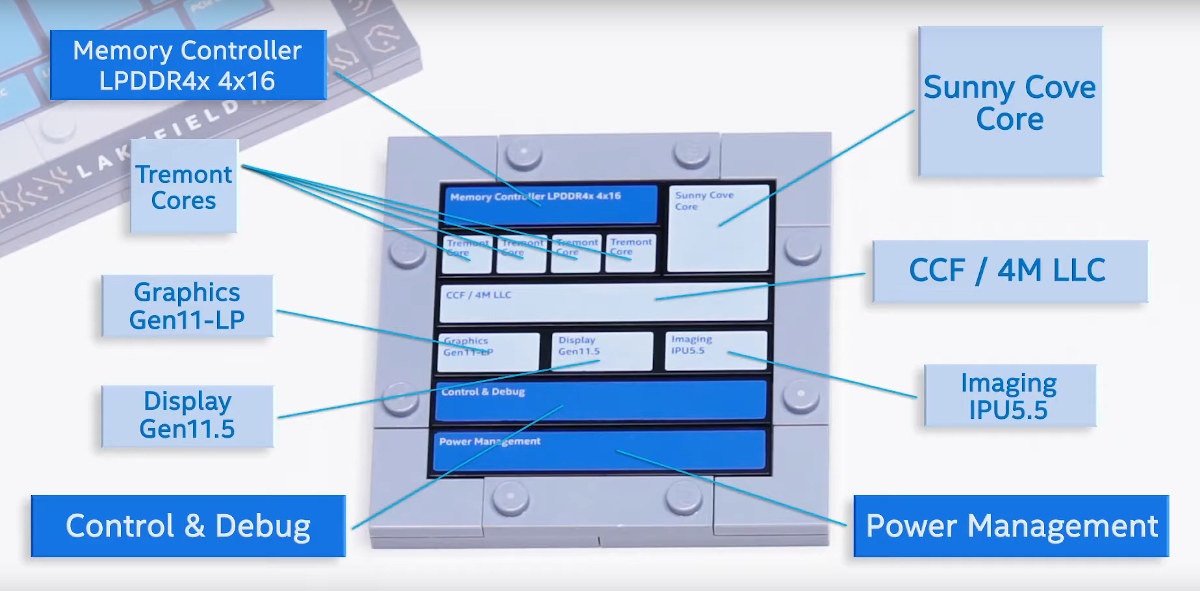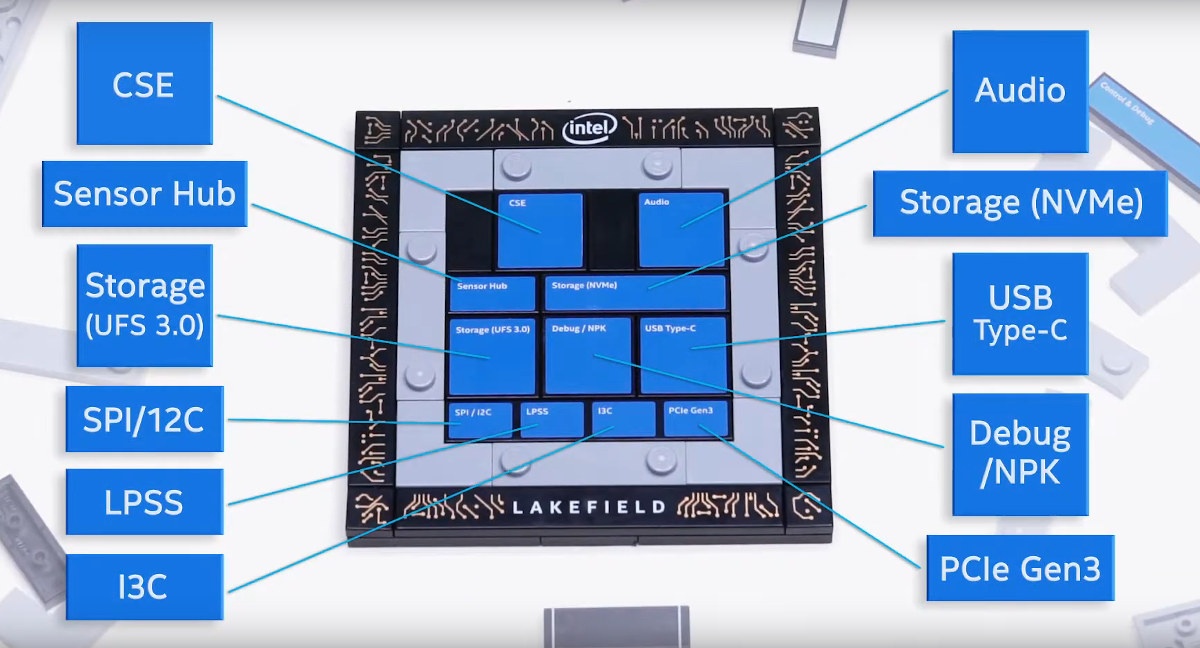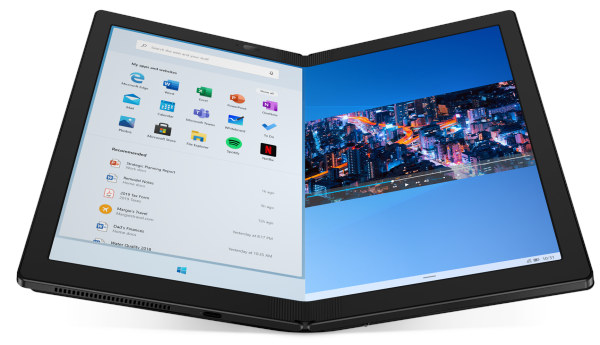Intel unveiled plans for Lakefield Hybrid processors last year which combined a high-performance Sunny Cove core with four low-power Atom cores using Foveros 3D stacking technology and offering high peak single-thread performance and low power consumption for most tasks in a similar way to Arm’s big.LITTLE or DynamIQ technology.
The company has now launched the first two penta-core Lakefield hybrid processors with Core i5-L16G7 and Core i3-L13G4 processors both with a 7W SDP (Scenario Design Power), but no TDP number which makes sense considering the Hybrid nature of the processor.

Main features and specifications of the processors:
- Intel Core i3-L13G4
- CPU – 1x high-performance Sunny Cove core @ 800 MHz / 2.8 GHz (Boost), 4x low-power Atom Tremont cores; All-core turbo boost: 1.3 GHz
- 4 MB Cache
- GPU – 48EU Intel UHD Graphics Gen11-LP @ 200 / 500 MHz with DX12, OpenGL4.5 API, and up to 4x independent displays
- Intel Core i5-L16G7
- CPU – 1x high-performance Sunny Cove core @ 1.4 GHz / 3.0 GHz (Boost), 4x low-power Atom Tremont cores; All-core turbo boost: 1.8 GHz
- 4 MB Cache
- GPU – 68EU Intel UHD Graphics Gen11-LP @ 200 / 500 MHz with DX12, OpenGL4.5 API, and up to 4x independent displays
- Memory I/F – Up to 8GB LPDDR4X-4267 POP (Package-on-Package, meaning memory and SoC should be integrated into a single package)
- Storage I/F – UFS 3.0 and NVMe
- Display – Gen11.5 display processor up to 5k60 and 4k120 video output
- USB – USB Type-C interface
- PCIe – Up to 6x PCIe Gen 3.0 lanes
- Low-speed interfaces – SPI, I2C, LPSS, I3S
- Process – 10 nm
You’ll find a detailed side-by-side comparison on Intel Ark website.

Intel explains the new hybrid processors are designed for thin tablets and laptops and offer the following benefits:
- 12 x 12 x 1mm package stacking two logic dies and two layers of DRAM in three dimensions
- Hardware-guided OS scheduling helps the hybrid CPU deliver up to 24% better performance per SOC power and up to 12% faster single-threaded integer compute-intensive application performance compared to Intel Core i7-8500Y Amber Lake processor.
- 2x throughput on Intel UHD for AI-enhanced workloads such as video stylization, analytics, and image resolution upscaling.
- Improved multimedia performance – Up to 1.7x better graphics performance (3DMark 11) and the system converts video clips up to 54% faster (Handbrake RUG 1213)
- Gigabit connectivity with support for Intel Wi-Fi 6 (Gig+) and Intel LTE solutions
- Low power consumption – As low as 2.5mW of standby SoC power – an up to 91% reduction compared to Y-series processors

The first products based on the new Intel Lakefield hybrid processors will be Lenovo ThinkPad X1 Fold a foldable tablet with a 13.3-inch display, and Samsung Galaxy Book S laptop expected to launch “later this year” and “starting in June” respectively. I’d expect those to compete against always-on always-connected mobile PCs powered by Arm-based Snapdragon 8cx processor in terms of price, performance, and battery life, and Samsung Galaxy Boos S should also have a model based on Snapdragon 8cx.

Jean-Luc started CNX Software in 2010 as a part-time endeavor, before quitting his job as a software engineering manager, and starting to write daily news, and reviews full time later in 2011.
Support CNX Software! Donate via cryptocurrencies, become a Patron on Patreon, or purchase goods on Amazon or Aliexpress





And they had to castrate the Sunny Cove core by removing AVX and up extensions because Tremont doesn’t have them. But I guess it won’t be a big deal for most because performance isn’t the main selling point.
is it not “only” avx-512 that was disabled on the sunny cove core ?
that’s what i understood after reading anandtech article
Not sure. On ark they say “SSE4.1/SSE4.2” for the instruction set extensions and they clearly mention AVX on other CPUs. Given how power-hungry AVX is (it reduces the turbo frequency on some models), I’m not surprized it’s absent from atoms/celeron/pentium CPUs where SSE might be quite enough.
It stops at SSE4.2 according to the link to Ark that Jean-Luc posted. That would not be the first time Ark is wrong, but in this case I tend to think it’s correct as you want the same ISA on all cores to ease process migration/scheduling.
Thanks Jean-Luc for the explanation. I noticed them this morning on ARK and couldn’t figure how these 5 cores were organized even though I suspected that at least one of them was different. Now it gets clearer 🙂
Thanks JL, for this in-detail article without any delay.
This seems like a bit of shame really. You have the platform that works the best with Linux but it looks like it’s going to get used in Windows 10 devices and not ChromeOS or Android ones.
One must admit that Linux is less sensitive to the architecture than Windows, and that other excellent big-little SoCs already exist that are well supported on Linux. With that said, you’ll note that they’ve placed 6 PCIe lanes, which implies they expect it to be used in various configurations if it succeeds. You can imagine various set-top-boxes, storage systems or laptops, beyond tablets. It’s probably just a matter of time.
The limiting factor will always be the same with intel: the SoC’s price. At $281, this chip costs way more than a finished product based on a high-end ARM chip, and they might fail at putting it into mobile devices again just like they failed with atoms in the past solely for this same reason: their CPUs are not competitive at all.
They probably plan to compete against $1000+ Snapdragon 8cx laptops.
Seems so. The Samsung press release for the ‘Galaxy Book S’ also babbles about ‘always-on LTE’.
Thats a lot of money for turning a computer into a always on terminal, i woukd suggest.
> At $281
The ‘Recommended Customer Prize’ for Intel CPUs no average customer can buy directly (SoCs) is more or less an irrelevant number. Gemini Lake SoCs like J4105 were listed with $107.00 on Ark which is just way above what ASRock charged for any of their J4105 motherboards (A customer got a bunch for less than 60€).
Even Hardkernel managed to price the naked ODROID H2 for $111 using the very same J4105 listed for $107.
Then this is a POP SoC with up to 8GB LPDDR4 included. So what does the price on Ark mean anyway?
Beautiful! I want one!
Wondering if they can update these cpu/gpu combinations (on a roadmap including 2023) to energy-saving pcie4 revisions?
They even show i3c connect.
My “Intel® Core™ i3-6006U” is also $281.00 on ARK, exactly like these hybrid processors. So maybe “$281.00” is some kind of Intel speak for a certain real price, or “hey, just call us”. Each IRL buyer then knows what he/she can expect.
“$281.00” gives 712 results on ark.intel.com. So really looks some standard price. Message to the real, bulk buyers: wink, wink.
The price has never been realistic on Ark, except maybe for socketed processors? I remember a few years back Intel Atom Z3735F processor was listed for around $35 in volume, but we could get Z3735F mini PCs or PC sticks for around $70 and up shipped…
Example: https://www.cnx-software.com/2016/04/26/mele-pcg02u-ubuntu-tv-stick-is-now-available-for-70/
Indeed. Real bulk price is probably 1/2 or 1/3 of the ARK price.